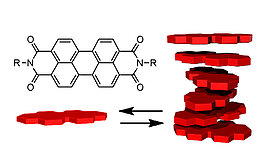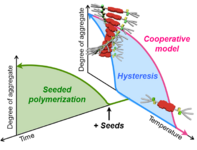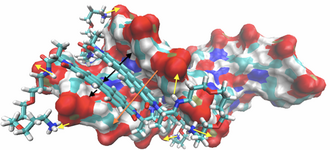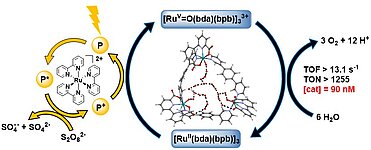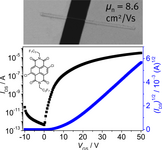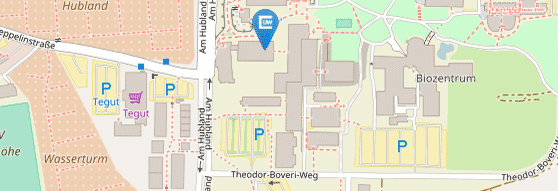The research programme of our group
Our research is devoted to the development of advanced organic materials based on functional dyes such as perylene and naphthalene bisimides, merocyanines, squaraines, chlorins and diketopyrrolopyrroles by employing supramolecular approaches. Towards this objective, we design and synthesize novel molecular building blocks and explore their self-assembly into nanoscale architectures and liquid-crystalline and crystalline solid-state materials that are applied in (opto-)electronic and photovoltaic devices as weil as in photocatalytic water splitting.
Our current research topics:
Synthetic Dye Chemistry
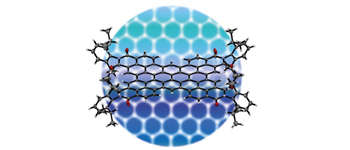
An important advantage of molecular materials is given by the possibility to tune theirfunctional properties by proper choice of the core structure and attachment of suitablesubstituents. This, together with control of their packing arrangements, affords functionalmaterials for various purposes. In our current research we develop new synthetic strategiesto one- and twodimensional p-scaffolds (das p ist ein griechisch "pi") by palladium-catalyzedcoupling-annulation cascade reactions. With regard to properties we are interested influorescence and phosphorescence, HOMO and LUMO levels and biradical character.
C. Zhu et al., J. Am. Chem. Soc. 2022, 144, 36, 16282-16286; Supramolecular Substructure of C60-Embedded Schwarzite DOI: 10.1021/jacs.2c06933
M. Mahl et al., Nat. Chem. 2022, 14, 457-462; Multilayer stacks of polycyclic aromatic hydrocarbons DOI: 10.1038/s41557-021-00861-5
K. Shoyama et al., J. Am. Chem. Soc. 2019, 141, 13008-13012; Synthesis of a Carbon Nanocone by Cascade Annulation DOI: 10.1021/jacs.9b06617
Dye Assembly
Mechanistic elucidation, including thermodynamic and kinetic analyses of self-assembly processes of functional dyes by UV/Vis/NIR absorption, fluorescence and CD spectroscopy and isothermal titration calorimetry. Structural and morphological characterization of supramolecular assemblies by 2D NMR, DLS, high-resolution MS, AFM, STM, SEM and TEM. Exploration of electrochemical and photo-physical properties of supramolecular assemblies by cyclic voltammetry, spectroelectrochemistry and time-resolved spectroscopy.
D. Bialas et al., Nat. Sci. 2022, 2, e210430; Supramolecular p/n-heterojunction of C60-functionalized bis(merocyanine) quadruple stack: A model system for charge carrier separation and recombination in organic solar cells DOI: 10.1002/ntls.20210430
A. Schulz et al., Angew. Chem. Int. Ed. 2022, 61, e202114667; Folding-induced Fluorescence Enhancement in a Series of Merocyanine Hetero-Folda-Trimers DOI: 10.1002/anie.202114667.
D. Bialas et al., J. Am. Chem. Soc. 2021, 143, 12, 4500-4518; Perspectives in Dye Chemistry: A Rational Approach toward Functional Materials by Understanding the Aggregate State DOI: 10.1021/jacs.0c13245
Supramolecular Polymers and Soft Matter
Construction of supramolecular polymers and block copolymers of functional dyes by seeded living polymerization and elucidation of their (opto) electronic properties. Developmentof thermotropic and lyotropic (chromonic) liquid-crystalline and gel materials based on H-bonding perylene bisimides and squaraines. Analysis of condensed phase materials by POM, DSC and XRD techniques.
L. Kleine-Kleffmann et. al., J. Am. Chem. Soc. 2023, 145, 16, 9144-9151; Controlling the Supramolecular Polymerization of Squaraine Dyes by a Molecular Chaperone Analogue DOI: 10.1021/jacs.3c01002
M. Wehner et. al., Nature Chem. Rev. 2020, 4, 38-53; Supramolecular polymerization through kinetic pathway control and living chain growth DOI: 10.1038/s41570-019-0153-8
M. Wehner et. al., J. Am. Chem. Soc. 2019, 141, 14, 6092-6107; Supramolecular Polymorphism in One-Dimensional Self-Assembly by Kinetic Pathway Control DOI: 10.1021/jacs.9b02046
lnteraction with Biomacromolecules
Development of water-soluble fluorescent dyes and their supramolecular assemblies and exploration of their interactions with biological components like DNA, proteins, and cellular systems for sensing, imaging and therapeutic applications
J. Dietzsch et al., Angew. Chem. Int. Ed. 2022, 61, e202116783; Tuning Exciton Coupling of Merocyanine Nucleoside Dimers by RNA, DNA and GNA Double Helix Conformations DOI: 10.1002/anie.202116783
J. M Farrell et al., Angew. Chem., Int. Ed. 2017, 56, 11846-11850; A Doubly Boron-Doped Perylene by N-Heterocylic Carbene-Borenium Hydroboration—C-H Borylation—Dehydrogenation DOI: 10.1002/anie.201706346
J. Gershberg et al., Chem. Eur. J. 2015, 21, 7886-7895; Sensing of Double-Stranded DNA/RNA Secondary Structures by Water Soluble Homochiral Perylene Bisimide Dyes.DOI: 10.1002/chem.201500184
Supramolecular Photocatalysis
Development of multicomponent architectures containing functional dye based light harvesting antennae systems and photosensitizers as solar fuel production catalysts for the implementation into photo-reactors. Construction of metallosupramolecular architectures like one-dimensional nanofibers or two-dimensional macrocycles containing ruthenium water oxidation catalysts.
T. Schlossarek et al., Angew. Chem. Int. Ed. 2022, 61, e202211445; Self-assembled Ru(bda) Coordination Oligomers as Efficient Catalysts for Visible Light-Driven Water Oxidation in Pure Water DOI: 10.1002/anie.202211445
N. Noll et al., Nat. Cat. 2022, 5, 867-877; Enzyme-like water preorganization in a synthetic molecular cleft for homogeneous water oxidation catalysis DOI: 10.1038/s41929-022-00843-x
S. Karak et al., J. Am. Chem. Soc. 2022, 144, 38, 17661-17670; A Covalent Organic Framework for Cooperative Water Oxidation DOI:10.1021/jacs.2c07282
Organic Materials for (Opto-)electronics
Highly purified functional small molecules can be processed either from solution or by sublimation in vacuum to investigate their propensity as solid state materials for applications in organic thin-film transistors and organic bulk heterojunction solar cells. Structure properties relationships are established by correlation between single crystal and thin-film X-ray analysis.
J. Kim et al., Adv. Mater. 2022, 34, 2104678; Slip-Stacked J-Aggregate Materials for Organic Solar Cells and Photodetectors DOI: 10.1002/adma.202104678
T. He et al., Nat. Mater. 2021, 20, 1532-1538; Site-specific chemical doping reveals electron atmospheres at the surfaces of organic semiconductor crystals DOI: 10.1038/s41563-021-01079-z
J. Kim et al., Adv. Mater. 2021, 33, 2100582; An Efficient Narrowband Near-Infrared at 1040 nm Organic Photodetector Realized by Intermolecular Charge Transfer Mediated Coupling Based on a Squaraine Dye DOI: 10.1002/adma.202100582



